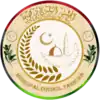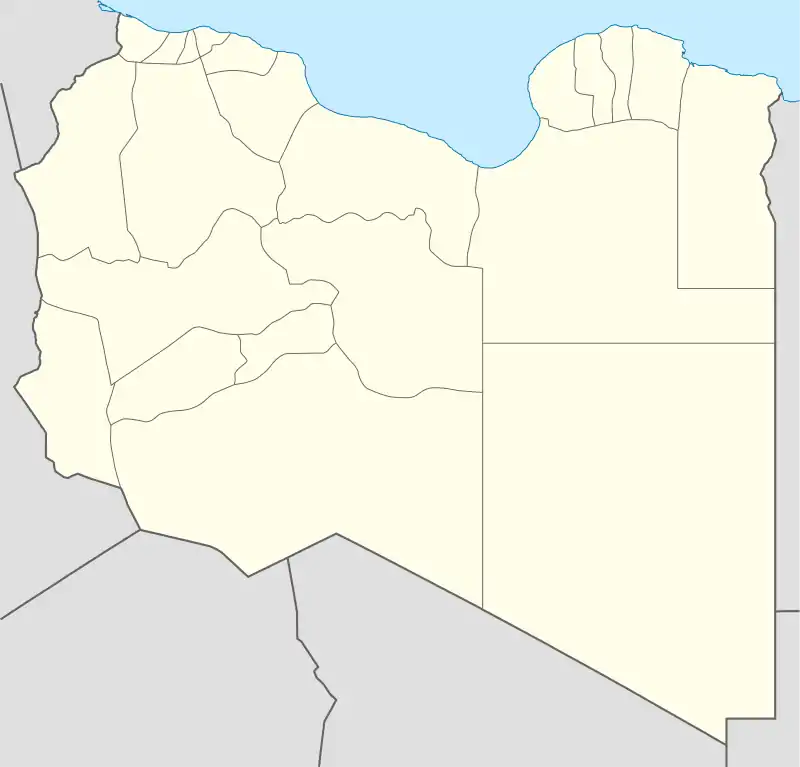Tarhuna
ترهونة | |
|---|---|
Town | |
 Seal | |
 Tarhuna Location in Libya | |
| Coordinates: 32°26′02″N 13°38′04″E / 32.43389°N 13.63444°E | |
| Country | |
| Region | Tripolitania |
| District | Murqub |
| Elevation | 1,289 ft (393 m) |
| Population (2011)[2] | |
| • Total | 13,264 |
| Time zone | UTC+2 (EET) |
| License Plate Code | 27 |
Tarhuna (/tɑːrˈhuːnə/; Arabic: ترهونة), also Tarhoona or Tarhunah, is a Libyan village 65 kilometres (40 mi) to the southeast of Tripoli, in the Murqub District. The Tarhuna District, including the city of Msallata, had an urban population of about 296,000 (est. 2003). The population in Tarhuna proper was calculated to be 13,264 in 2011.[2]
Geographical boundaries: from the "Valley of the famm Molgha" west to "Burkaat Oueny" eastward. Then from the "Suq al Juma (Al-msab`ha)" north, " Al-mzawgha and Marghna" south.[3]
History
In the city centre of Tarhuna, just opposite the Tarhuna mosque, there is a memorial to Ali Swidan Alhatmy, who was a hero in the 18 June 1915 Battle of El-Shqiga against the Italians. He was captured in 1922 and hanged by the Italians in the town square.
The population generally belongs to the Tarhuna tribe, which was favoured during the regime of Muammar Gaddafi. In late August 2011 (as part of the Libyan Civil War), opposition forces from the National Liberation Amy entered Tarhuna, amidst mixed feelings from the citizens.[4]
On 23 August 2012, Interior ministry spokesman Abdelmonem al-Hur stated that more than a hundred tanks and twenty-six rocket launchers were seized from an alleged pro-Gaddafi militia (named Katibat Al-Awfiyah, or Brigade of the Faithful), during a raid on their campsite in Tarhuna. The operation ended with one of the suspects killed, eight wounded and thirteen detainees, accused of being linked with the 19 August Tripoli bombings.[5][6][7]
According to reports in The Washington Post, Tarhuna was dominated between 2011 and 2020 by the Kani brothers and their militia, the Kaniyat. Imposing a reign of terror, the Kaniyat were allegedly responsible for hundreds of killings in the town, with the collusion of the Government of National Accord.[8] In 2019, the Kaniyat switched allegiance to the warlord Khalifa Haftar-led LNA forces during the Second Libyan Civil War, and became the LNA's stronghold in western Libya. On 18 April 2020, the forces of the UN-recognized GNA government, with the backing of Turkish drones, launched a major offensive with the aim to reclaim Tarhuna from Haftar.[9] On 5 June, it was captured by the GNA.[10] Explosive devices, landmines, and mass graves of civilians, many buried alive, were discovered in the city.[11]
During the late 1950s and into the 1960s, the RAF established a bombing range on the outskirts of the town. It was manned by RAF personnel from nearby RAF Idris and it was used by Canberra bombers from various bases in Germany. The range consisted of a main control tower with full equipment for communication with the bomber crews, at 45 degrees to the left was a quadrant tower to cross reference the plotting of the bomb hits, to convey the strike position of each bomb, and a target constructed out of 45 gallon oil drums, filled with concrete and built into a pyramid approximately 40-50 foot high and painted white. The range was used to practice the art of a new manouvre known as LABS (low altitude bombing system), where the bomb is launched in a lob towards the target, so that by the time the bomb hits the target, the aircraft has retreated at high altitude and at high speed./RAF records Paul Adey</ref></ref>
Economy
Tarhuna is a leading producer of olive oil, cereals, figs, grapes, sparto grass, and various nuts.
Education
The Faculty of Law of Al Nasser University is located north of town.[12]
Notable people of Tarhuna
- Ahmed Al-Mraied. Commander – tribes Tarhunah – during the period of resistance against the Italian colonization in Tarhunah – a four bosses for – Republic of Tripoli – was chosen to be heads the Shura Council of the Republic of Tripoli – as it was named chairman of the Reform Party National 30 September 1919 – was elected president of the Conference of Gharyan 1920 and the presidency of the Commission reform central
- Al-Mabrouk Al-Montaser. Born in the Suq Al-Ahad in Tarhunah – was commander of the fighters in the western region of Tarhunah against Italian forces – in battles (Shara`a Ash Shat – Ain Zara – Beyr Terffas). Emigrated to Egypt after the end of the resistance in Libya
- Giovanni Innocenzo Martinelli (1942–2019), Libyan-Italian Roman Catholic prelate
- Ali Al-Abany. Born in Al-Ghomen Village Tarhuna 1946 – Painter – studied painting in Italy and graduated excellent grade – founding member (Club Painters) in Tripoli in 1960 – won an award – the Golden Sail – of the State of Kuwait in 1975.
- Mohammed Az Zwawey. Highlighted Caricaturist in Libya – Born in the suburbs of Benghazi in 1936, died on Sunday, 5 June 2011
- Ahmed Mukhtar Al-Tarhuni. Photographer winning several awards locally and internationally and the Arab world
- Suleiman Altarhuni. Lyricist – wrote lyrics known in Libya, including (weenak weenak) artist Mohamed Hassan
Sport
Founded in Tarhunah many sports clubs: Al-Noor School club ( teachers club ) - Al-Amal Club was founded in 1960 - the hero of the Football League in the central region - currently playing in the third division Al-Shabeba Club Club Soqor Al-Sag`ya
See also
Notes
- ↑ Wolfram Alpha
- 1 2 "Data from World Gazetteer". Archived from the original on 4 December 2012.
- ↑ "Libya 2003 Census of Population" Libyan national authority for information and authentication, archive from Internet Archive, 21 January 2008
- ↑ "Gadhafi loyalists remain firm." Archived 23 May 2012 at the Wayback Machine Concord Monitor/AP, 31 August 2011. Retrieved 2011-08-31.
- ↑ "At least 12 killed in tribal clash in Libya". NBC. Reuters. 23 August 2012. Archived from the original on 4 January 2013. Retrieved 11 September 2012.
- ↑ "Libya seizes tanks from pro-Gaddafi militia". BBC. 24 August 2012. Retrieved 10 September 2012.
- ↑ "Tanks seized from pro-Gaddafi militia". Courier Mail. 24 August 2012. Retrieved 11 September 2012.
- ↑ Raghavan, Sudarsan (8 May 2021). "Libyan mass graves: Kaniyat militia accused of Tarhuna killings". The Washington Post. Retrieved 10 May 2021.
- ↑ "Casualties as LNA, GNA Forces Clash in Tripoli, Tarhuna". aawsat.com. 19 April 2020.
- ↑ "Libyan government says it has entered Haftar stronghold Tarhouna". 5 June 2020. Retrieved 5 June 2020 – via uk.reuters.com.
- ↑ "UN chief shocked at Libya mass graves in recently freed town". news.yahoo.com. Retrieved 13 June 2020.
- ↑ Azema, James (2000). Libya Handbook: The Travel Guide. Footprint. p. 119. ISBN 978-1-900949-77-4.
External links
- "Tarhuna, Libya" Falling Rain Genomics, Inc.
- "Photo gallery of al_allagi"
- "Photo gallery of al_Maradi"